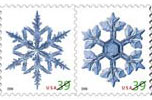| 真实照片:世间没有两朵相同的雪花(图) |
| http://www.sina.com.cn 2006/01/17 11:16 国际在线 |
Through rain and sleet and dead of night and all that, your letters next winter can be delivered bearing snowflakes artfully photographed by a physicist who weathers those same storms to study nature's crystal magic. Starting in October, the U.S. Postal Service will issue a set of four stamps featuring pictures of snowflakes taken by Kenneth Libbrecht, a professor of physics at the California Institute of Technology. For years, Libbrecht has been studying the physics of snowflakes, looking at the different patterns of crystal growth and snowflake formation. "I'm trying to understand the dynamics of how crystals grow, all the way down to the molecular level," Libbrecht said. "This is a very complicated problem, and I've been looking at ice as a particularly interesting case study." Snowflakes are nothing more than ice, but the forms a single flake can take are dizzyingly complex. A single crystal of ice is known as a snow crystal. And one or more snow crystals stuck together make a snowflake. There is, as you've heard, endless possibilities for how they stick together. When Libbrecht started making snowflakes in the laboratory, he took microscopic photographs in order to be able to study the basic physics of each flake. In 2001, he started capturing images of natural snowflakes. Location is important. "Fairbanks sometimes offers some unusual crystal types, because it's so cold," Libbrecht said. "Warmer climates, for example, in New York State and the vicinity, tend to produce less spectacular crystals." "I visit the frozen North and wait for snow to fall," Libbrecht said in a recent email interview. "I'm in northern Ontario right now." Since ice is mostly clear, the flakes have to be lit properly to reveal their beauty. "I use different types of colored lights shining through the crystals, so the ice structures act like complex lenses to refract the light in different ways. The better the lighting, the more interesting is the final photograph." He has to work quickly, using a paintbrush to place a flake into his portable studio for the shoot. When flakes have fallen, they stop growing and within minutes they typically lose their sharp edges and become less interesting. The pictures have helped Libbrecht describe a growth instability in snowflakes that other researchers had missed. By applying high voltage to a growing snow crystal in the lab, Libbrecht is able to analyze unique growth mechanisms, especially on very small scales. "These instabilities are new and important for understanding how crystals grow, but they're hard to explain," Libbrecht told LiveScience. Nonetheless, the knowledge can be applied in making semiconductors, solid materials whose electrical conductivity operates many electronic gadgets. Semiconductors are made in part by condensing certain substances into solid forms. The Holiday Snowflakes stamps will feature multi-branched stellar dendrites, with six symmetrical main branches and many randomly placed side branches and sectored plates. These represent but one of seven primary types of snowflake patterns. As you'd expect, no two of the stamps are alike. But what about out in the field? Are they really all different? "The answer is basically yes, because there is such an incredibly large number of possible ways to make a complex snowflake," Libbrecht said. "In many cases, there are very clear differences between snow crystals, but of course there are many similar crystals as well. In the lab we often produce very simple, hexagonal crystals, and these all look very similar." |
| 真实照片揭示:世间没有两朵相同的雪花(图) |
从今年10月份开始,美国邮政总局将发行一套印有雪花图片的邮票,这些图片均是由美国加州理工学院的物理学教授肯尼斯-里布雷希特经过多年野外作业拍摄到的雪花照片。这些精美的照片也揭示了一个事实,那就是世间不会有两朵相同的雪花。 据美国“生活科学”网站1月15日报道,真实的雪花照片告诉人们,雪花形状结构的变化多端远比我们想象的更为惊人。雪花的成分除了冰之外几乎别无他物,一个或更多的冰晶组合成为雪花,组合方式有无限的可能性,因此,几乎每个雪花的结构都是一个令人眩目的复杂结合体。 里布雷希特教授研究雪花的物理形态已有好几年时间,主要是观察晶体变大和雪花组成的不同类型。“我试图搞清楚晶体成长的动力所在,一直分析到分子水平,这是个非常复杂的问题。” 里布雷希特日前在接受电子邮件采访时写道:“费尔班克斯有时会发现不同寻常的结晶类型,因为那里非常冷。而在较为温暖的气候中,比如纽约州或邻近地区,就不太会出现好看的结晶。近几年,我一直访问北部寒冷的地区,在那里等待下雪。目前正在安大略的北部。” 里布雷希特还说:“我利用不同颜色的光照射晶体,冰晶结构就像复杂的棱镜一样将光线折射到不同的方向。光束的颜色质量越好,最后的照片效果就越有意思。”对里布雷希特来说,这份工作最关键的地方就是速度。发现特别的雪花之后,他要用画笔迅速地将雪花放在移动工作室中进行拍摄。降落下来之后,雪花的体积就不再增大,而且只要几分钟时间,尖锐的边缘就会消失,变得不再那么“有意思”了。 (文/程瑶) |
| 【发表评论】 |
|
|
| 【评论】【论坛】【收藏此页】【大 中 小】【多种方式看新闻】【下载点点通】【打印】【关闭】 |
